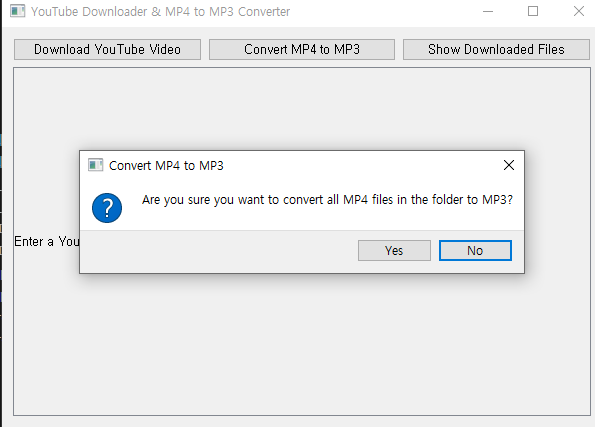PyQt5와 requests 및 BeautifulSoup를 이용해 URL을 입력하고, 해당 웹 페이지의 내용을 크롤링하여 보여주는 기본 프로그램.
입력한 URL의 HTML 내용과 크롤링된 특정 텍스트 내용을 보여주는 두 개의 영역

import sys
import requests
from bs4 import BeautifulSoup
from PyQt5.QtWidgets import QApplication, QWidget, QVBoxLayout, QLabel, QLineEdit, QPushButton, QScrollArea, QTextBrowser, QTextEdit
from PyQt5.QtCore import Qt
class WebCrawlerApp(QWidget):
def __init__(self):
super().__init__()
self.initUI()
def initUI(self):
# 창 설정
self.setWindowTitle("URL Web Crawler")
self.setGeometry(300, 300, 800, 600)
# 메인 레이아웃 설정
layout = QVBoxLayout()
# URL 입력창 및 버튼 추가
self.url_input = QLineEdit(self)
self.url_input.setPlaceholderText("Enter URL here...")
layout.addWidget(self.url_input)
self.submit_button = QPushButton("Submit", self)
self.submit_button.clicked.connect(self.fetch_web_content)
layout.addWidget(self.submit_button)
# HTML 내용 표시 (링크 지원을 위해 QTextBrowser 사용)
self.html_label = QLabel("Page HTML Content:")
layout.addWidget(self.html_label)
self.html_content = QTextBrowser(self)
self.html_content.setOpenExternalLinks(False) # QTextBrowser 내부에서 링크 클릭 이벤트를 처리
self.html_content.anchorClicked.connect(self.handle_link_click)
html_scroll = QScrollArea(self)
html_scroll.setWidgetResizable(True)
html_scroll.setWidget(self.html_content)
layout.addWidget(html_scroll)
# 크롤링된 내용을 보여줄 텍스트 창
self.crawl_label = QLabel("Crawled Data:")
layout.addWidget(self.crawl_label)
self.crawled_content = QTextEdit(self)
self.crawled_content.setReadOnly(True)
crawl_scroll = QScrollArea(self)
crawl_scroll.setWidgetResizable(True)
crawl_scroll.setWidget(self.crawled_content)
layout.addWidget(crawl_scroll)
# 레이아웃 설정
self.setLayout(layout)
def fetch_web_content(self):
# URL 가져오기
url = self.url_input.text().strip()
if not url:
self.html_content.setText("Please enter a valid URL.")
return
try:
# 웹 페이지 요청 및 파싱
response = requests.get(url)
response.raise_for_status()
html_text = response.text
# HTML 내용을 보여줌
self.html_content.setHtml(html_text)
# BeautifulSoup으로 HTML 파싱
soup = BeautifulSoup(html_text, 'html.parser')
# 특정 태그 내용 크롤링 예시 (모든 <p> 태그 내용)
paragraphs = soup.find_all('p')
crawled_data = "\n\n".join([p.get_text(strip=True) for p in paragraphs])
# 크롤링된 내용 표시
if crawled_data:
self.crawled_content.setText(crawled_data)
else:
self.crawled_content.setText("No <p> tags found on the page.")
except requests.exceptions.RequestException as e:
self.html_content.setText(f"Error fetching the URL: {e}")
self.crawled_content.setText("")
def handle_link_click(self, url):
# 링크를 클릭하면 URL 입력창에 설정하고 자동으로 Submit
self.url_input.setText(url.toString())
self.fetch_web_content()
# 애플리케이션 실행
if __name__ == "__main__":
app = QApplication(sys.argv)
window = WebCrawlerApp()
window.show()
sys.exit(app.exec_())'프로그래밍 > Python' 카테고리의 다른 글
| [python] Sunburst Chart (0) | 2024.11.26 |
|---|---|
| [python] What’s New in Python 3.13 (0) | 2024.11.19 |
| [python] 파이썬, pyQT 이용한 유튜브 영상다운로드, 변환,파일리스트 (6) | 2024.11.13 |
| [python] 폴더 안의 모든 mp4 파일을 mp3로 변환하기 (0) | 2024.11.12 |
| [python] youtube download 입력받은 url로 다운받기 (5) | 2024.11.12 |








